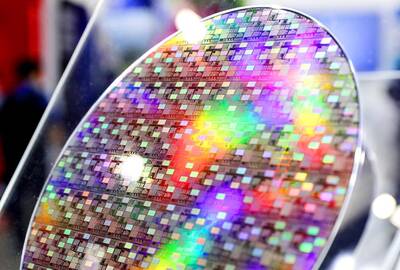Fujitsu Ltd, Japan’s biggest computer-services provider, said profit at its semiconductor business will probably be ¥10 billion (US$107 million) in the 12 months to March 31, 2011, rebounding from a ¥15 billion loss this fiscal year.
The Tokyo-based company aims to cut costs at the business by ¥80 billion over two years to March 2011, it said in a statement yesterday. Fujitsu will jointly develop 28 nanometer chips with Taiwan Semiconductor Manufacturing Co (TSMC) and outsource production to the Hsinchu-based company.
Fujitsu president Kuniaki Nozoe is selling the company’s money-losing hard-disk-drive business to Toshiba Corp and outsourcing some chip production to TSMC to cut costs and return to profit. A lower spending burden and cost reductions will help make the chip operations profitable next fiscal year, the company said in April.
“It’s becoming increasingly unfeasible for companies in the chip industry to shoulder capital expenditures alone, making partnerships an essential way to improve efficiency,” Haruki Okada, who heads the chip business at Fujitsu, said at a briefing in Tokyo yesterday. “Chip demand has passed its lowest point and has been in recovery since February.”
Fujitsu declined 2.9 percent to ¥631 on the Tokyo Stock Exchange yesterday afternoon. The benchmark Nikkei 225 Stock Average fell 1.6 percent.
The company aims to achieve a record ¥15 billion operating profit at the semiconductor unit in the 12 months ending March 2012, it said.
Fujitsu’s net income will probably reach ¥95 billion in the year ending next March, compared with a ¥112.4 billion loss a year earlier, the company said last week. The outlook includes ¥89 billion from the sale of 12 million Fanuc Ltd shares, Fujitsu said at the time.
The loss at Fujitsu’s chip business, which comprises order-made devices and semiconductors used in flat-panel televisions, mobile phones and servers, will narrow to ¥15 billion this fiscal year from ¥60 billion in the previous 12 months, the company said in April.
A nanometer is one-billionth of a meter and measures the width of transistors in a chip, where a smaller gap means more transistors can be packed on each wafer.

WAITING GAME: The US has so far only offered a ‘best rate tariff,’ which officials assume is about 15 percent, the same as Japan, a person familiar with the matter said Taiwan and the US have completed “technical consultations” regarding tariffs and a finalized rate is expected to be released soon, Executive Yuan spokeswoman Michelle Lee (李慧芝) told a news conference yesterday, as a 90-day pause on US President Donald Trump’s “reciprocal” tariffs is set to expire today. The two countries have reached a “certain degree of consensus” on issues such as tariffs, nontariff trade barriers, trade facilitation, supply chain resilience and economic security, Lee said. They also discussed opportunities for cooperation, investment and procurement, she said. A joint statement is still being negotiated and would be released once the US government has made

NEW GEAR: On top of the new Tien Kung IV air defense missiles, the military is expected to place orders for a new combat vehicle next year for delivery in 2028 Mass production of Tien Kung IV (Sky Bow IV) missiles is expected to start next year, with plans to order 122 pods, the Ministry of National Defense’s (MND) latest list of regulated military material showed. The document said that the armed forces would obtain 46 pods of the air defense missiles next year and 76 pods the year after that. The Tien Kung IV is designed to intercept cruise missiles and ballistic missiles to an altitude of 70km, compared with the 60km maximum altitude achieved by the Missile Segment Enhancement variant of PAC-3 systems. A defense source said yesterday that the number of

‘CRUDE’: The potential countermeasure is in response to South Africa renaming Taiwan’s representative offices and the insistence that it move out of Pretoria Taiwan is considering banning exports of semiconductors to South Africa after the latter unilaterally downgraded and changed the names of Taiwan’s two representative offices, the Ministry of Foreign Affairs (MOFA) said yesterday. On Monday last week, the South African Department of International Relations and Cooperation unilaterally released a statement saying that, as of April 1, the Taipei Liaison Offices in Pretoria and Cape Town had been renamed the “Taipei Commercial Office in Johannesburg” and the “Taipei Commercial Office in Cape Town.” Citing UN General Assembly Resolution 2758, it said that South Africa “recognizes the People’s Republic of China (PRC) as the sole

Taiwanese exports to the US are to be subject to a 20 percent tariff starting on Thursday next week, according to an executive order signed by US President Donald Trump yesterday. The 20 percent levy was the same as the tariffs imposed on Vietnam, Sri Lanka and Bangladesh by Trump. It was higher than the tariffs imposed on Japan, South Korea and the EU (15 percent), as well as those on the Philippines (19 percent). A Taiwan official with knowledge of the matter said it is a "phased" tariff rate, and negotiations would continue. "Once negotiations conclude, Taiwan will obtain a better